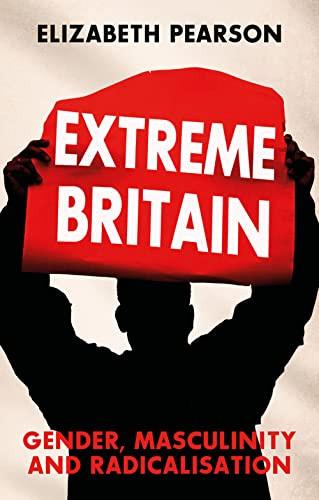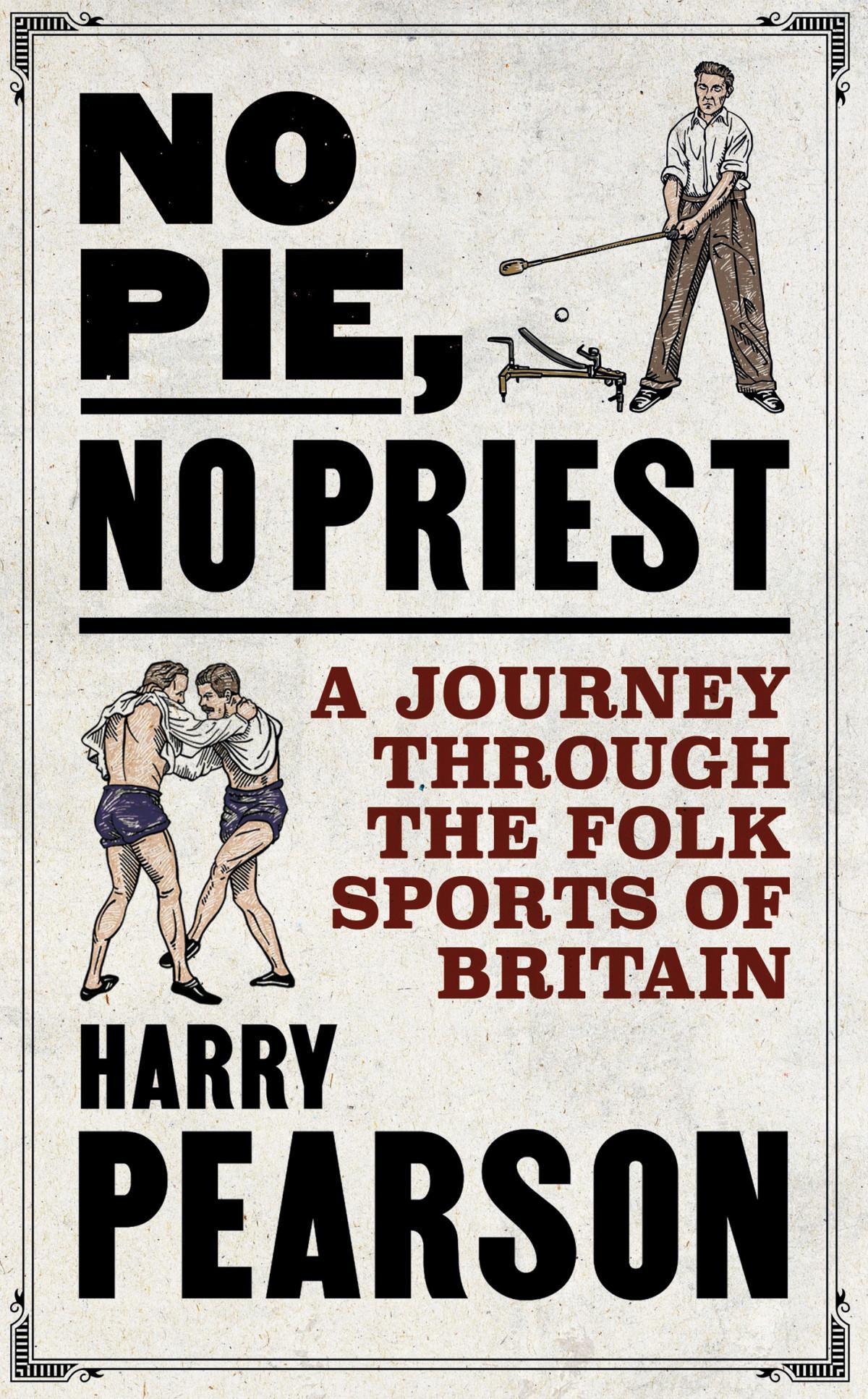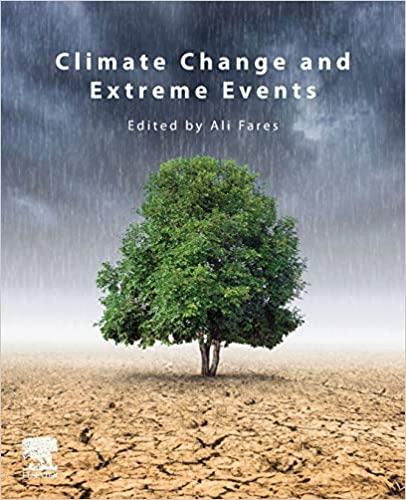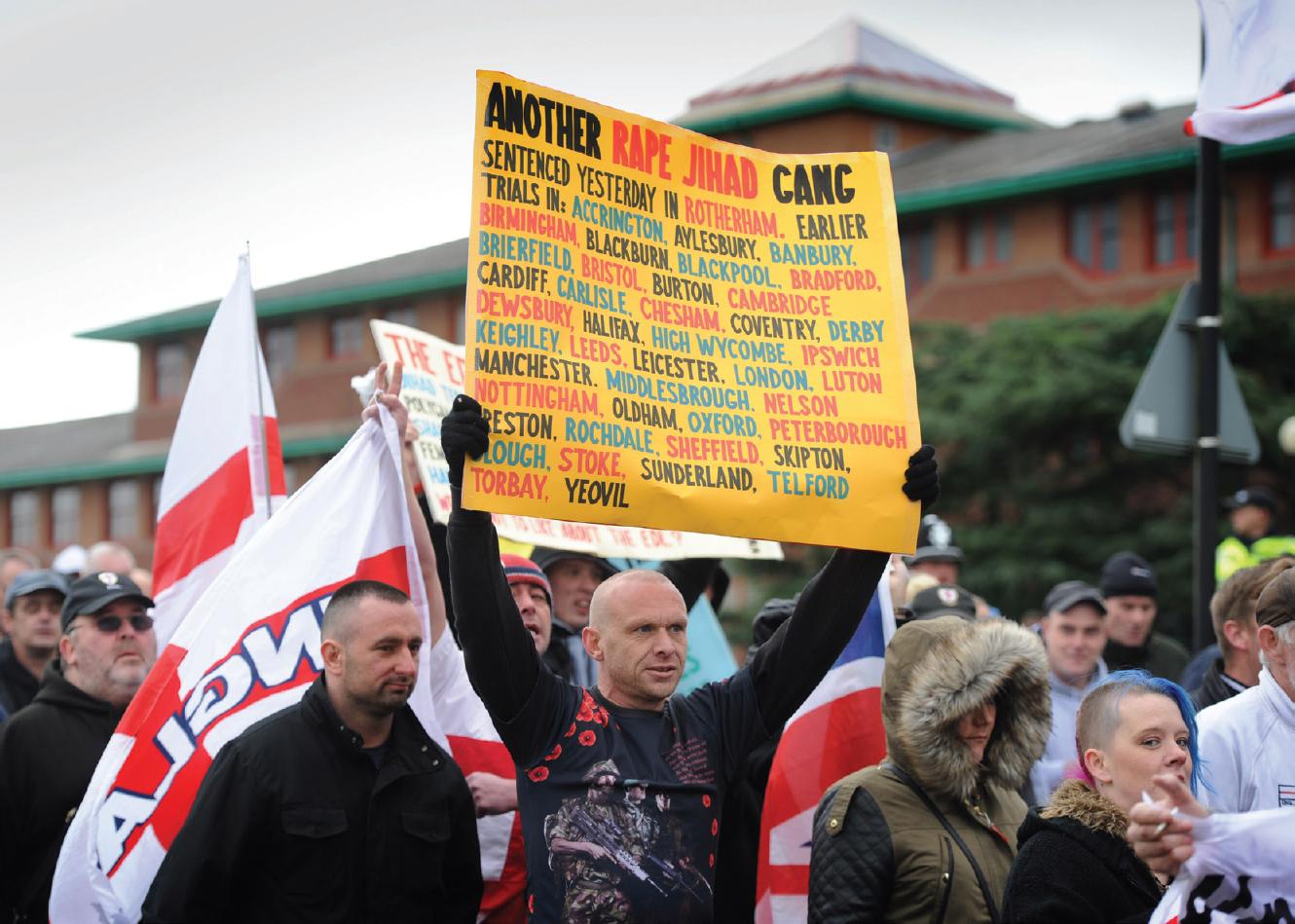ELIZABETH PEARSON
Extreme Britain
Gender, Masculinity andRadicalisation
HURST & COMPANY, LONDON
First published in the United Kingdom in 2023 by C. Hurst & Co. (Publishers) Ltd., New Wing, Somerset House, Strand, London, WC2R 1LA
Copyright © Elizabeth Pearson, 2023
Printed in the United Kingdom
All rights reserved.
The right of Elizabeth Pearson to be identified as the author of this publication is asserted by her in accordance with the Copyright, Designs and Patents Act, 1988.
A Cataloguing-in-Publication data record for this book is available from the British Library.
ISBN: 9781787389465
www.hurstpublishers.com
1. EDL demonstration, Telford, 5 November 2016.
2. ‘Working Class Hero’ sign at a ‘Free Tommy Robinson’ protest, London, 9 June 2018.
3. Protestor in a homemade Robinson T-shirt, Britain First demonstration, Rochdale, 22 July 2017.
4. Flags, branded T-shirts and drums: White Lives Matter demonstration, Margate, 22 October 2016.
5. Britain First demonstration, Telford, 25 February 2017.
2017.
6. Women leading a Britain First demonstration, Rochdale, 22 July
7. Anne Marie Waters leading an “Islam Kills Women” event, London, 20 August 2016.
CONTENTS
Acknowledgments
ListofAbbreviations
ListofIllustrations
Introduction
1. Theory: Masculinities and Extremism
2. Methodology: Is it OK to Talk to Extremists?
3. The Radical Right: Situating Masculinities
4. The Radical Right: Mobilising Masculinities
5. The Radical Right: Misogyny, Masculinities and Women’s
Leadership
6. ALM: Situating Masculinities
7. ALM: Mobilising Masculinities
8. Conclusions
Appendix
Glossary
Notes
Bibliography
Index
ACKNOWLEDGMENTS
This book would not exist without those ‘extremists’ who gave their time to talk to me, some briefly, some at length. I am grateful to everyone who shared their story with me. We are never likely to agree, but I hope you find yourselves fairly represented within these pages. I have been incredibly lucky since I started out in academia, first with a Master’s, then with the PhD from which this book grew. Special thanks are due to Katherine Brown, Jelke Boesten, John Bew and War Studies and Defence Studies at King’s College London; and to the ESRC, without which this research would not have been possible. Also, to Michael Dwyer and Lara Weisweiller-Wu at Hurst for being patient while life took unexpected turns. And to Laura Sjoberg and the anonymous reviewers–David Duriesmith and Leonie Jackson–whose comments helped improve earlier drafts of this work. Nonetheless, all errors remain my own.
Many people have supported me in the research and writing stages of this book and I will always try to pay that forward. This list is not exhaustive but includes: teams at RUSI, IISS and RAN and
Hurst; Christine Cheng, Doug Weeks, Brooke Rogers, Wyn Bowen, Susanne Krieg, Jackie Gower, Alexander Meleagrou-Hitchens, Maura Conway, Lisa McInerney, Marysia Zalewski, Laura Shepherd, Marsha Henry, Paul Higate, Paul Gill, Hilary Pilkington, Gavin Bailey, Jacob Zenn, Atta Barkindo, Adebiyi Kayode, Raff Pantucci, Emily Winterbotham, Andrew Glazzard, Saqeb Mueen, Sabrina Downey, Michael Clarke, Michael Kenney, Brett Kubicek, Sara Zeiger, Naureen Chowdhury Fink, Bruce Hoffman, Andrew Silke, Jonathan Bright, Jennifer Eggert, Virginia Comolli, Nelly Lahoud, Jayne Huckerby, Stuart Macdonald, Alastair Reed, J. M. Berger, Joe Whittaker, Victoria Williams, Alison Perry, Rebecca Lewis, the SALT team, Annie Mullins, Richard Graham, Suraj Lakhani, Will Baldett, Shereen Williams, Aleksander Dier, Alex Phelan, Michael Nwankpa, Chitra Nagarajan, Joana Cook, James Forest, Thomas Renard, Devorah Margolin, Rachel Bryson, Gina Vale, Innes Bowen, John Morrison, Emily Glorney, Nick Hardwick, Rosie Meeks, Akil Awan, Rob Jago, Ravinder Barn, Matthew Humphreys, Anthony Richards, Kaat Smets, Katy Vaughan, Ashley Mattheis, Joel Busher, Shiraz Maher, Vivienne Jabri, Jamie Bartlett, Carl Miller and Zeynep Sütalan, Daisy Leitch, and the copy-editing team at Hurst involved in creating this text. Also, Elizabeth Hurren, who knew I was bored.
There are many friends to thank too, including some of those listed above. You came with me to meet Anjem, listened to me talk endlessly about extremism, which probably wasn’t fun, distracted and entertained me, got me extra work when I was broke, and kept me going when I was giving up. Thank you.
Finally, my family, who always made sure we had books: handme-down, bought and borrowed. You are no longer all with me to see this book in print. I hope you would have been proud.
LIST OF ABBREVIATIONS
AfD AlternativefürDeutschlandAlternative for Germany
ALM Al-Muhajiroun
AQ Al-Qaeda
ASBO Anti-Social Behaviour Order
BBC British Broadcasting Corporation
BFP British Freedom Party
BF Britain First
BNP British National Party
CCE The Commission for Countering Extremism
CE Cumulative Extremism, also known as reciprocal radicalisation
CNN Cable News Network
CPS Crown Prosecution Service
CSE Child Sexual Exploitation
CSMM Critical Studies on Men and Masculinities
CT Counter-Terrorism
CVE Countering Violent Extremism
DFLA Democratic Football Lads Alliance
DV Domestic Violence
EDL English Defence League
FA Football Association
FB For Britain
FGM Female Genital Mutilation
FLA Football Lads Alliance
GBV Gender-Based Violence
HM Hegemonic Masculinity
HT Hizb ut-Tahrir
IDF Israeli Defence Force
IED Improvised Explosive Device
IR International Relations
IS Islamic State
ISIS Islamic State of Iraq and Syria
JAS Jamaat Ahlus Sunna Lidawati Wal Jihad/Boko Haram
LGBTQ+ Lesbian Gay Bisexual Trans Queer + identities
MAC Muslims Against Crusades
MAPPAs Multi-Agency Public Protection Arrangements
MUU Mixed, Unclear and Unstable
NA National Action
PBIED Person-Borne Improvised Explosive Device
Pegida Patriotische Europäer gegen die Islamisierung des Abendlandes
Patriotic Europeans Against the Islamification of the West
PTSD Post-Traumatic Stress Disorder
Q Question
SAS Special Air Service
SMT Social Movement Theory
TPIM Terrorism Prevention and Investigation Measure
TS Terrorism Studies
UKIP United Kingdom Independence Party
UNSCR United Nations Security Council Resolution
UP United Patriots
WLM White Lives Matter
WOT War on Terror
WPS Women, Peace and Security
LIST OF ILLUSTRATIONS
Author note: This book covers both the radical right and Islamists networked to al-Muhajiroun. However, only the radical right are featured in the illustrations; Al-Muhajiroun–linked events are not represented for legal reasons and the preservation of participant anonymity.
1. EDL demonstration, Telford, 5 November 2016. Courtesy of Express&Starnewspaper.
2. ‘Working Class Hero’ sign at a ‘Free Tommy Robinson’ protest, London, 9 June 2018. Photo by Daniel Leal/AFP via Getty Images.
3. Protestor in a homemade Robinson T-shirt, Britain First demonstration, Rochdale, 22 July 2017. Photo by Elizabeth Pearson.
4. White Lives Matter demonstration, Margate, 22 October 2016. Penelope Barritt/Alamy Stock Photo.
5. Britain First demonstration, Telford, 25 February 2017. Photo by Elizabeth Pearson.
6. Women leading a Britain First demonstration, Rochdale, 22 July 2017. Photo by Elizabeth Pearson.
7. Anne Marie Waters leading an “Islam Kills Women” event, London, 20 August 2016. Vickie Flores/Shutterstock.
INTRODUCTION
Robert is maybe60, in a blue fleece. He did sixyears in the air force, he says, butthey don’t make theplanes anymore. All thecuts, it’s totallydepleted. He’s also worried about the schools—theTrojanHorsecases. Themediaissweepingitall under the carpet, he says. Another guy comes over, more aggressive. Who are you, he asks, are you Antifa? He’s tall, bent over, in my face. Gavin, he’s called. Gavin from Gateshead. No, I say. So, do Iagree with it all, what Britain First are doing? No, I say. By now the crowd is transformed into waving Union Jacks. The main banner is brought to the front and Jayda calls for ‘the ladies’ to come forward.1 They start to march. Abigangry guy in a Nike top is shouting at Asian families watching from theirdoorsteps.2 Theygive him thefinger . Themarcherschant,“Keep StGeorge inmyheart, keep me English…!”, “There’s only one Lee Rigby!”, and the coreanthem,“BritainFirst!FightingBack!”. Notes from my field diary, Rochdale, 22 July 2017
What masculinities are evident here, on the streets of Rochdale, England, in July 2017? And what does gender have to tell us about extremism in Britain today? A recent report on extremism in the UK suggests far-right street protest is on the rise again.3 However, initial research on this book began in markedly different times. Leaders of the key groups considered, including Tommy Robinson, Anjem Choudary and Jayda Fransen, have now all served time in prison; indeed Choudary faces possible further prison time after being charged with three terror offences in July 2023. Fransen has left Britain First and spoken publicly of the domestic violence she alleges she suffered from Leader Paul Golding during her time there. Social media platforms removed some of these figures, then allowed them back, then removed some of them again. Since 2014 and the outset of the study, Islamic State has been defeated in Syria and Iraq. The so-called hijrahof British, or any other, jihadis to these countries has ended, and there is little political interest in and much public hostility towards bringing them back.
Additionally, both Brexit and COVID-19 have arguably disrupted the UK’s political landscape with a shift to the populist right, mirroring similar shifts across Europe and beyond.4 Lockdown legislation produced more distrust in, and contestation of, the state. Mistrust of statistics combined with deliberate disinformation by badfaith actors has amplified conspiracy theorists. Lines between extreme or not, threat or not, are blurred. In July 2023, Elon Musk, the billionaire owner of Twitter—now rebranded ‘X’—caused consternation when he ‘liked’ tweets on immigration by Golding.5 It was reminiscent of 2017, when then President Trump retweeted Fransen, then Deputy Leader of Britain First, leading her to gain 45,000 new followers. Twitter expelled her some weeks later, while the President, whose views on Islam appeared not dissimilar, remained.6 Whether American voters re-elect Trump, whose activities are followed with avid interest by the British radical right, remains to be seen at the time of writing in 2023. Given hostile British Government policies towards immigration, interviews cited in this book reveal a radical right whose views increasingly resemble
dominant discourse; and, furthermore, a movement that frequently rejects its characterisation in political terms of left- or right-wing at all. The situation is not better than it was when I ended the research, and dealing with it is ever more urgent.
What is extremism? The term is no easier to define at the time of writing than when I began research for the book in 2014. And yet this book is all about extremists. It is not easy to interview them— they are not keen on academics—but protests are a good place to start. I attended sixteen events—radical-right and Islamist—and interviewed some thirty-one extreme activists in depth during my research for this book, some of whom I got to know well. If people talked to me, it was because we had a rapport, or they were bored, or curious, or perhaps saw me as a useful mouthpiece. We engaged with each other as people. I disagreed with them on everything, but there were people whom I liked. When police raided one Islamist participant and ultimately charged him with terrorism offences, it was me he turned to for help. Nobody I interviewed expected I would understand them, and I make no claims here that I do.
This book is based on those interviews. I use analysis of them to make an argument: that radicalisation, the process towards extremism, is a project of masculinity. As I write, there is a great deal of popular as well as academic interest in how misogyny and masculinities factor into extremism. This is progress. For too long, both have been ignored. However, while it is often argued that the same misogyny and toxic masculinity are at the heart of the far right and jihadism alike, here I explore the complexities of gender and masculinities (plural) in forging different types of extreme activism. Yes, there is extreme misogyny—understood as the policing and punishment of women who fail to conform to norms supporting patriarchy7 and it is important to recognise and combat this; extreme women are often subordinate within their own groups. However, there is also room for extreme women to set the agenda, to lead and mobilise other women, albeit with pushback from patriarchy. Women are also often the victims of extremist groups.
In this world of culture wars, some people are gender sceptics. They think gender studies is harmful, perhaps. Or they wonder, what can thinking about masculinities tell us about extremism that we don’t already know? Can gender really matter that much in understanding Britain’s radicalisation? The answer is an emphatic yes. This book argues for the importance of gender in understanding the masculinity project that is radicalisation. Additionally, it argues that misogyny matters in radicalisation to both movements discussed, the radical right and ALM. However, the misogyny evident in both movements is not easily distinguishable from misogynies in wider society, or the social norms and backgrounds from which the extreme actors emerge. Extreme identities are not distinct. Extremists have more in common with us than we would like to think.
Whatthisbookisabout
It goes without saying that this book is about extremists. My focus was also on masculinities, and what they would tell me about misogyny in the groups studied. However, the central research question asked was, how does gender matter in extremism? This led me to a more fundamental question: how would I know what extremism is, and therefore who extremists are? The 2015 UK government’s Prevent duty guidance refers back to the 2011 Prevent Strategy for a definition of extremism, which is “the vocal or active opposition to our fundamental values, including democracy, the rule of law, individual liberty and the mutual respect and tolerance of different faiths and beliefs.” The government “also regard calls for the death of members of our armed forces as extremist.”8 It is jihadist terrorism that successive CONTEST counter-terrorism strategies have identified as the principal threat to the UK, with the far right secondary.9 The extremism definition was crafted explicitly to reference actors across Britain’s radical-right and Islamist movements. In turn, radicalisation is understood by the UK government as the “process by which people become involved in
terrorism or extremism leading to terrorism”.10 It is widely acknowledged in the academic literature, however, that there is no one radicalisation process; radicalisation is not scientific, and can hardly even be labelled a ‘process’ at all.11 Furthermore, the terms ‘extremism’ and ‘radicalisation’ themselves are contentious and politicised, as will be explored in Chapter One.
Understanding extremism matters, given that counter-terrorism discourse increasingly relies on the above definition. Anthony Richards, a key scholar of definitions of terrorism, has identified a vogue for discourses of extremism over radicalisation and a concomitant muddying of the waters.12 What is more there is no consensus over extremism as a relative or objectively measurable state. The 2009 UK counter-terrorism strategy CONTEST equates extremism with the undermining of “shared values”.13 In his 2013 review of the literature, Alex P. Schmid concurs, regarding extremism as inherently relational, defined relative to mainstream societal views as well as the rule of law.14 He suggests that extremism concerns ideology, behaviours and connectedness. However, since Schmid’s work was published, the key contribution to defining extremism has come from American academic J. M. Berger in his book Extremism.15 He disagrees with Schmid on the relational definition. Berger addresses a clear problem: if society’s core values undergo an apparent shift as arguably has been witnessed in both Europe and the United States since the election of several right-wing populist leaders—this impacts the continued framing of only minority groups as extreme. Berger borrows from Henri Tajfel’s Social Identity Theory, which posits the idea of the in-group (our own) and the outgroup (the other, irredeemably different from ourselves).16 Berger’s definition is focused on the denigration of out-groups. He defines extremism as:
the belief that an in-group’s success or survival can never be separated from the need for hostile action against an outgroup. The hostile action must be part of the in-group’s definition of success. Hostile acts can range from verbal
attacks and diminishment to discriminatory behavior, violence, and even genocide.17
This definition has become a new benchmark for policymakers and academics in understanding extremism. Perhaps it is not a surprise that it does not reference gender. Gender theorists have persistently highlighted the security studies landscape’s historic neglect of gender.18 This has been particularly true in the subfields of terrorism, extremism and radicalisation.19 The situation is, however, changing. One might even say that the field has become obsessed with the function of gender, particularly anti-feminist movements and misogyny, in terrorism since the identification of the incel movement as a contemporary threat. Greater focus on misogyny is urgently needed; we know that jihadist groups such as Islamic State, or Jamaat Ahlus Sunna Lidawati Wal Jihad (Boko Haram), specifically target women in their hostile actions against out-groups, and in certain ways, because they are women.20 Think of Islamic State’s bartering and rape of Yezidi women, or of jihadist abductions of young women students in Nigeria. Yet despite mention of genocide, Berger's definition does not highlight sexual and gender-based violence as a ‘hostile act’.
A further important definition therefore comes from the Commission for Countering Extremism (CCE) in a 2019 report under lead Commissioner Sara Khan, which prefaces the term ‘extremism’ with the word ‘hateful’. It defines “hateful extremism” as:21
Activity or materials directed at an out-group who are perceived as a threat to an in-group, who are motivated by or intending to advance a political, religious or racial supremacist ideology: a. To create a climate conducive to hate crime, terrorism or other violence; or b. Attempt to erode or destroy the fundamental rights and freedoms of our democratic society as protected under Article 17 of Schedule 1 to the Human Rights Act 1998.22
Gender is still not explicit in this definition. However, Khan’s foreword to the report notes of her research into extremism, “Some of the stories have left me heartbroken. People, young and old, have cried as they described how extremists targeted them because of their sexuality, their gender, their race or religious identity.”23 Both Khan’s response and her new suggested definition remind us of the affective outcomes of extremism: pain, hate, suffering.
Whothisbookisabout
This book is a study of gender in two of the most significant extremist movements in the United Kingdom in recent times: the radical right, an umbrella term for activists opposed to the perceived ‘Islamisation’ of Britain and Europe, and therefore Islam; and the Islamist movement linked to the now-proscribed group al-Muhajiroun (ALM) (meaning ‘the emigrants’ and referring to those who originally followed the Prophet to Mecca). Both movements have links to the current extremist scene. ALM is a Salafist–Islamist organisation, and the UK Government has long considered it and its Leader Anjem Choudary a key threat. Although officially the group named alMuhajiroun no longer exists, I interviewed Choudary and actors following him, some since ALM days, and therefore refer to this network in the book as ALM. This reflects ALM’s understanding that names do not matter; the call (to the group) matters.24 Much of the terminology in discussion of al-Muhajiroun and the actors connected to it is contested. Salafi–jihadi extremism and Islamism have been complex and controversial terms for some years.25 Scholars using the term ‘Islamism’ generally define this as political Islamic activism, distinguishing it from Islam as a faith. Salafi jihadism is the violent struggle to establish an Islamic Caliphate,26 and can be differentiated from other non-violent strands of Salafism.27 I use the term ‘jihad’ in this book in place of the phrase ‘violent jihad’, and for clarity, because that is how the participants used it. In Islam, the ‘greater jihad’ represents the personal spiritual struggle to live as a good Muslim. The ‘lesser jihad’ refers to the violent struggle for the
faith. Some do not like the term ‘Islamism’. Islamism is a diverse ideology, frequently divided into those groups who reject participation in democratic systems and those who do not.28 Rejectionists include Anjem Choudary and his followers, who advocate violence to achieve the establishment of Shariah law, with the caveat that this must take place only outside of the country of residence—their so-called ‘Covenant of Security’. Other groups, such as Hizb ut-Tahrir (HT), support democratic participation. While a number of authors make the distinction between political Islamism and purely religious Islam, this distinction is not made by any of the participants in this research.
While the book focuses on the interviews given by men—women were harder to interview, as Chapter Two explores—I also consider women’s navigation of extremism’s homosociality, and how they both adopt and resist masculinist norms and misogynies, as well as being constrained by them.
The key radical-right groups studied were the English Defence League (EDL), Britain First (BF) and For Britain (FB). There have been times in the years prior to the publication of this book when Tommy Robinson, a co-founder of the EDL, was barely out of the news. Nonetheless, since I conducted my research, many of the offline activities that once made the headlines hardly appear in the news at all. Free speech protests in 2018 saw thousands march to support him when he was jailed for contempt of court. At the time of writing, banned from mainstream social media platforms, Robinson is less visible, but no less active.29 Hope Not Hate’s 2022 report suggested that he had 180,000 followers on the alternative social media site GETTR and was making a “return”, exercising an antivaccine, anti-Boris agenda.30 By mid-2023 Robinson’s GETTR followership had increased to almost 235,000, and he was speaking out in support of online influencer and misogynist Andrew Tate and seemingly teaming up with Britain First’s Paul Golding, who remains on Twitter while Robinson does not. While anti-far right extremism charity Hope Not Hate notes an increase in far-right street activism, the EDL has all but disappeared.31 From 2016 to 2018, when I
attended demonstrations, pressure on activists was intense. The police filmed events; meanwhile far-left and Antifa activists used social media to shame and ‘out’ those at protests, hoping to see them lose their jobs.32 During my field research, perhaps only those with little to lose remained committed to street protest.
At the time of writing in mid-2023, Anjem Choudary has been rearrested and charged with three terrorism offences related to a proscribed organisation.33 However, like the radical right, ALM has largely been quiet. Anjem Choudary (also known as ‘the Sheikh’) was at one point almost the go-to media spokesperson for fringe Islamism, to the anger of most British Muslims. He was jailed in September 2016 alongside his younger colleague Mizanur Rahman (also known as Abu Baraa) for support of Islamic State (IS), the violent Islamist group that between 2014 and 2017 claimed and held territories in Syria and Iraq. Choudary has hardly been heard from publicly since, even though stringent release restrictions ended in July 2021.34 Terrorism Prevention and Investigation Measures (TPIMs), Anti-Social Behaviour Orders (ASBOs) and post-conviction Multi-Agency Public Protection Arrangements (MAPPAs) have been employed in the past to prevent activities such as Islamist congregation in public space and to restrict the employment, living arrangements, activities and associates of activists.35 In fact, writing in 2018, Michael Kenney suggested that measures against ALM meant the network was “just barely” surviving.36
There is no room for complacency. Islamic State may be militarily defeated, but its jihadist ideology remains a key security concern. And while we might not see activists on mainstream social media or in public spaces as much as in the past, it does not mean that they are no longer committed. Indeed, for jihadist groups a period of preparation and inactivity in violence is an important part of the fight. Both ALM and the radical right have proved resilient despite past external pressures. In fact, I chose these movements for this book not simply because they are resilient, or because their homosocial nature lends them to a gender analysis, but because they were for a long time understood to be linked through the



















